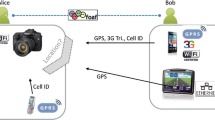Abstract
Any device we want to connect to a global network, e.g. Internet, should have a unique global identifier. However, the size of this identifier can be an unacceptable overhead for devices with limited resources (sensors, toys, disposable devices, micro-robots, etc.), because conventional protocols use full addresses to transmit, process, and store the data required for routing. The usual solution for such devices is to limit the address space to 1 or 2 bytes, but this sacrifices the global unicity of the identifiers. The proposal presented in this article enables devices with limited resources to use reduced addresses that globally identify hosts. We propose the use of abbreviated addresses for routing. We have developed a new protocol named ADSR that takes advantage of these new addresses. This protocol is a modified version of DSR based on the use of abbreviated addresses. The abbreviation procedure can lead to two different nodes having the same address, which we will term collision. ADSR allows rather than avoids collisions. The foundations of this protocol, and some results of an implementation are also presented in this article.
Similar content being viewed by others
References
Akyildiz I.F., Wang X., Wang W. (2005) Wireless mesh networks: A survey. Computer Network and ISDN Systems 47(4): 445–487. doi:10.1016/j.comnet.2004.12.001
Al-Karaki J., Kamal A. (2004) Routing techniques in wireless sensor networks: A survey. IEEE Wireles Communications 11: 6–28
Barrera P., Robles G., Cañas J., Martín F., Matellán V. (2005) Impact of libre software tools and methods in the robotics field. SIGSOFT Softw. Eng. Notes 30(4): 1–6 10. doi:10.1145/1082983.1083261
Bergbreiter, S., & Pister, K. (2003) Cotsbots: An off-the-shelf platform for distributed robotics. In Proceedings of the 2003 IEEE/RSJ international conference on intelligent robots and systems.
Boyd S., Ghosh A., Prabhakar B., Shah D. (2006) Randomized gossip algorithms. IEEE/ACM Transactions on Networking 14(SI): 2508–2530. doi:10.1109/TIT.2006.874516
Broch, J., Maltz, D. A., Johnson, D. B., Hu, Y. C., & Jetcheva, J. (1998). A performance comparison of multi-hop wireless ad hoc network routing protocols. In Mobile computing and networking (pp. 85–97). (ACM MOBICOM’98). citeseer.nj.nec.com/broch98performance.html.
Camp T., Boleng J., Davies V. (2002) A survey of mobility models for ad hoc network research. Wireless Communications and Mobile Computing (WCMC): Special issue on Mobile Ad Hoc Networking: Research, Trends and Applications 2(5): 483–502
Fall, K., & Varadhan, K. The ns manual. http://www.isi.edu/nsnam/ns/doc. UC Berkeley and Xerox PARC.
Greenfield A. (2006) Everyware: The dawning age of ubiquitous computing. Peachpit Press, Berkeley, CA, USA
IEEE Standars Association. (2007). 802.15.4a—2007 IEEE Standard for Information Technology.
Johnson, D., Hu, Y., & Maltz, D. (2007). The dynamic source routing protocol (dsr) for mobile ad hoc networks for ipv4. http://www.ietf.org/rfc/rfc4728.txt.
Kamal, A. E. (2007). Rmm: A realistic mobility model for mobile ad hoc networks. In In the proceedings of the IEEE international conference on communications (ICC).
Kawadia V., Kumar P. R. (2005) A cautionary perspective on cross-layer design. IEEE Wireless Communications 2(5): 3–11
Lewis T. G., Cook C. R. (1988) Hashing for dynamic and static internal tables. IEEE Computer 21: 45–56
Lin, C. R., & Gerla, M. (1997). Asynchronous multimedia multihop wireless networks. In Proceedings of IEEE INFOCOM’97 (pp. 118–125).
Myers A.D., Zruba G.V., Syrotiuk V.R. (2002) An adaptive generalized transmission protocol for ad hoc networks. Mobile Networking and Applications 7(6): 493–502. doi:10.1023/A:1020773021569
Ortuño-Pérez, M. A. (2006). Protocolo de encaminamiento en origen con identificadores no únicos para redes ad-hoc de dispositivos con recursos limitados. Ph.D. thesis, Universidad Rey Juan Carlos, Madrid.
Ortuño-Pérez, M. A., Matellán, V., Rodero, L., & Robles, G. (2005). Abbreviated dynamic source routing: Source routing with non-unique network identifiers. In Proceedings of WONS 2005. Second Annual Conference on Wireless On-demand Network Systems and Services. IEEE Computer Society (pp. 76–82).
Perkins, C., Belding-Royer, E., & Das, S. (2003). Ad hoc on-demand distance vector (aodv) routing. http://www.ietf.org/rfc/rfc3561.txt.
Perkins C.E. (2001) Ad hoc networking. Addison-Wesley, Reading
Satyanarayanan, M., et al. (2001). Pervasive computing: Vision and challenges. citeseer.ist.psu.edu/satyanarayanan01pervasive.html.
Mullender, S., van Rossum, G., Tanenbaum, A., van Renesse, R., & van Staveren, H. (1990). Amoeba: A distributed operating system for the 1990. IEEE Computer.
Talucci, F., & Gerla, M. (1997). MACA-BI (MACA by invitation) a wireless MAC protocol for high speed ad hoc networking. In Proceedings of IEEE PIMRC’97 (pp 913–917).
Tang, K., & Gerla, M. (2000). MAC layer broadcast support in 802.11 wireless networks. In Proceedings of IEEE MILCOM 2000.
Tang, K., & Gerla, M. (2001). MAC reliable broadcast in ad hoc networks. In Proceedings of IEEE MILCOM 2001.
Weiser M. (1991) The computer for the 21st century. Scientific American 265(3): 94–104
Yick J., Mukherjee B., Ghosal D. (2008) Wireless sensor network survey. Computer Networks 52(12): 2292–2330
Yoon, J., Liu, M., & Noble, B. (2003). Random waypoint considered harmful. In Proceedings of IEEE INFOCOM 2003 (pp. 1312–1321).
ZigBee Alliance: ZigBee Home Page. http://www.zigbee.org/.
Author information
Authors and Affiliations
Corresponding author
Rights and permissions
About this article
Cite this article
Ortuño-Pérez, M.A., Matellán-Olivera, V., Agüero-Durán, C.E. et al. Low-Cost Identifiers for Ubiquitous Computing. Wireless Pers Commun 63, 101–127 (2012). https://doi.org/10.1007/s11277-010-0110-9
Published:
Issue Date:
DOI: https://doi.org/10.1007/s11277-010-0110-9




